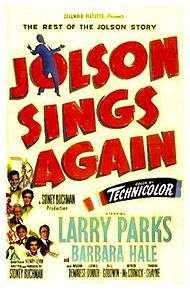Jolson Sings Again
Jolson Sings Again is a 1949 American musical biographical film directed by Henry Levin, and the sequel to The Jolson Story (1946), both of which cover the life of singer Al Jolson. The film received three Oscar nominations at the 22nd Academy Awards.
| Jolson Sings Again | |
|---|---|
 1949 Theatrical Poster | |
| Directed by | Henry Levin |
| Produced by | Sidney Buchman |
| Written by | Sidney Buchman |
| Starring | Larry Parks Barbara Hale William Demarest Ludwig Donath |
| Music by | George Duning Morris Stoloff |
| Cinematography | William E. Snyder |
| Edited by | William A. Lyon |
Production company | Columbia Pictures |
| Distributed by | Columbia Pictures |
Release date |
|
Running time | 96 min |
| Language | English |
| Box office | $5 million (est. US / Canada rentals)[1][2] |
Synopsis
In this follow-up to The Jolson Story, we pick up the singer's career just as he has returned to the stage after a premature retirement. But his wife has left him and the appeal of the spotlight is not what it used to be. This time Jolson (Larry Parks) trades in the stage for life in the fast lane: women, horses, travel. His father (Ludwig Donath) becomes increasingly concerned about his frivolous lifestyle. With the death of his mother (Tamara Shayne) and the beginning of World War II, Jolson comes back to earth—and returns to the stage.
Once again teamed with manager Steve Martin (William Demarest), Jolson travels the world entertaining troops everywhere from Alaska to Africa. When he finally collapses from exhaustion it takes young, pretty nurse Ellen Clark (Barbara Hale) to show him there is more to life than "just rushing around".
Cast
- Larry Parks as Al Jolson / Larry Parks
- Barbara Hale as Ellen Clark
- William Demarest as Steve Martin
- Ludwig Donath as Cantor Yoelson
- Bill Goodwin as Tom Baron
- Myron McCormick as Ralph Bryant
- Tamara Shayne as Moma Yoelson
- Eric Wilton as Henry (uncredited)
Reception
Jolson Sings Again was eagerly awaited by moviegoers who remembered The Jolson Story, and hundreds of theaters showed the sequel to excellent response. It became Columbia Pictures' most successful film of 1949 and was the second highest-grossing film of that year after Samson and Delilah.
Reviews
"Jolson Sings Again bids fair to par The Jolson Story grosses and may even top them. In short, a smasheroo of unqualified proportions."[3]:8 "...Jolson's voice is still a formidable, awesome, and grandiously captivating instrument."[4]
"There is heart, humor, tragedy and a warm sprinkling of sentiment in Mr. Buchman's story. Much of the latter is conjured up by a succession of nostalgic songs which run all through the film and are sung in grand style by Mr. Jolson himself. The vitality of the Jolson voice is suitably matched in the physical representation provided by Larry Parks, who by now comes close to perfection in aping the vigorous expression with which Jolson tacks a song."[5]:16
Commentary
"Jolson Sings Again is a well-made sequel to The Jolson Story. In some ways, it betters the original. If anything, Jolson's voice sounds even better in this movie, and Larry Parks' Jolson is a warmer, more human character here."[6]
In this sequel, the story reaches the point in Jolson's life where the film of his life is to be made (first film: The Jolson Story), and in preparation for the film Jolson meets the actor who is to portray him. In what is probably a cinema first, Parks plays both Jolson and himself (the young Larry Parks) as they meet in a split-screen scene.[6] :116–117
Awards and nominations
| Year | Award | Category | Nominee(s) | Result |
|---|---|---|---|---|
| 1950 | 22nd Academy Awards | Best Story and Screenplay | Nominated | |
| Best Scoring of a Musical Picture | Nominated | |||
| Best Cinematography, Color | Nominated | |||
| 2nd Writers Guild of America Awards | Best Written Musical | Nominated | ||
Footnotes
- "All Time Domestic Champs", Variety, 6 January 1960 p. 34
- "Top Grossers of 1949". Variety. 4 January 1950. p. 59.
- Abel Green, Variety, August 1949
- Philip Hamburger. New Yorker, August 27, 1949, pp. 37-38
- Thomas M. Pryor, New York Times, August 18, 1949
- James Fisher. "Al Jolson - a Bio-bibliography" (1994)
External links
| Wikimedia Commons has media related to Jolson Sings Again. |